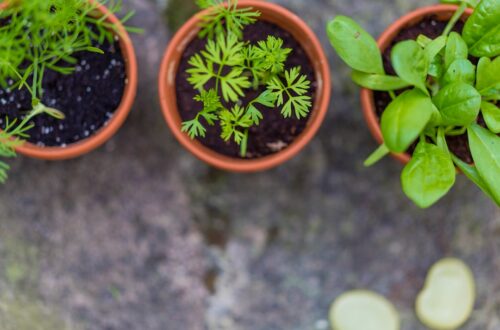Stephania Erecta, also known as the “Craib’s Caudiciform,” is a unique and visually striking plant that belongs to the Menispermaceae family. This plant is native to Thailand, where it thrives in tropical and subtropical climates. The Stephania Erecta is characterized by its thick, twisted, and knobby caudex, which serves as a water storage organ. The caudex can grow to impressive sizes, making this plant a popular choice among collectors and enthusiasts. The plant’s foliage consists of large, heart-shaped leaves that add to its overall appeal. Stephania Erecta is a relatively low-maintenance plant, making it an excellent choice for both beginner and experienced plant owners. With the right care and attention, this plant can thrive and become a stunning addition to any indoor or outdoor space.
Stephania Erecta is a slow-growing plant that can reach heights of up to 3 feet, making it an ideal choice for those looking for a compact yet visually impactful plant. Its unique caudex and lush foliage make it a standout addition to any plant collection. This plant is also known for its ability to go dormant during the winter months, making it an adaptable and resilient choice for various climates. With its striking appearance and low-maintenance nature, Stephania Erecta is a popular choice for plant enthusiasts looking to add a touch of exotic beauty to their homes or gardens.
Key Takeaways
- Stephania Erecta is a unique and exotic plant known for its unusual appearance and easy care requirements.
- It thrives in bright, indirect light and prefers temperatures between 65-85°F, making it suitable for most indoor environments.
- When it comes to watering, it’s important to allow the soil to dry out between waterings and maintain moderate humidity levels.
- A well-draining, aerated soil mix and a balanced fertilizer during the growing season will keep Stephania Erecta healthy and thriving.
- Propagation is best done through division or by planting tubers, and repotting should be done sparingly to avoid disturbing the plant’s delicate root system. Keep an eye out for common pests and diseases such as spider mites and root rot, and take prompt action to prevent any issues from escalating.
Light and Temperature Requirements
Stephania Erecta thrives in bright, indirect light, making it an excellent choice for indoor spaces with ample natural light. When grown indoors, it is best to place the plant near a south or west-facing window where it can receive plenty of sunlight without being exposed to direct rays. If growing Stephania Erecta outdoors, it is essential to provide it with partial shade to protect it from intense sunlight, especially during the hottest parts of the day. In its natural habitat, this plant grows under the canopy of trees, where it receives dappled sunlight, making it important to replicate these conditions when growing it at home.
In terms of temperature requirements, Stephania Erecta thrives in warm and humid conditions. It is best suited for USDA hardiness zones 10-12, where temperatures remain consistently warm throughout the year. When grown indoors, it is essential to keep the plant in a room with temperatures ranging between 65-85°F (18-29°C). Avoid placing the plant in areas with drafts or sudden temperature fluctuations, as this can cause stress and damage to the plant. Overall, providing the right balance of light and temperature is crucial for the health and growth of Stephania Erecta.
Watering and Humidity Needs
When it comes to watering Stephania Erecta, it is essential to strike a balance between keeping the soil moist and avoiding waterlogged conditions. During the growing season, which typically spans from spring to fall, it is best to water the plant when the top inch of the soil feels dry to the touch. This allows for adequate moisture without risking overwatering, which can lead to root rot and other issues. It is important to water the plant thoroughly, allowing excess water to drain from the bottom of the pot to prevent water buildup around the roots.
In terms of humidity needs, Stephania Erecta benefits from moderate to high humidity levels, especially during the growing season. To increase humidity around the plant, consider using a humidifier or placing a tray filled with water and pebbles near the plant. Misting the foliage occasionally can also help create a more humid environment for the plant. During the winter months when the plant goes dormant, it is important to reduce watering and humidity levels to mimic its natural growth cycle. By paying attention to watering and humidity needs, you can ensure that Stephania Erecta remains healthy and vibrant throughout the year.
Soil and Fertilizer Recommendations
“`html
| Soil Type | Recommended Fertilizer | Application Rate |
|---|---|---|
| Clay soil | Organic fertilizer | 50 lbs per 1000 sq ft |
| Sandy soil | Nitrogen-rich fertilizer | 25 lbs per 1000 sq ft |
| Loamy soil | Phosphorus and potassium fertilizer | 40 lbs per 1000 sq ft |
“`
Stephania Erecta thrives in well-draining soil that allows excess moisture to escape easily. A recommended soil mix for this plant consists of a combination of peat moss, perlite, and coarse sand. This mix provides adequate aeration and drainage while retaining enough moisture to support the plant’s growth. When repotting or planting Stephania Erecta, ensure that the pot has drainage holes at the bottom to prevent water from accumulating around the roots.
In terms of fertilizer recommendations, it is best to feed Stephania Erecta with a balanced liquid fertilizer diluted to half strength during the growing season. Fertilize the plant every 4-6 weeks to provide it with essential nutrients for healthy growth. During the dormant season, it is best to withhold fertilizer as the plant’s growth slows down. Always follow the instructions on the fertilizer label and avoid over-fertilizing, as this can lead to salt buildup in the soil and cause harm to the plant. By using the right soil mix and providing appropriate fertilization, you can support the overall health and vitality of Stephania Erecta.
Propagation and Repotting Tips
Propagating Stephania Erecta can be done through division or by collecting and planting its seeds. When dividing the plant, carefully separate the caudex and roots into smaller sections, ensuring that each division has enough roots to support its growth. Plant each division in a well-draining soil mix and provide it with appropriate care to encourage new growth. When collecting seeds from mature plants, allow the seeds to dry before planting them in a suitable soil mix.
When it comes to repotting Stephania Erecta, it is best to do so during the active growing season when the plant shows signs of outgrowing its current container. Choose a pot that is slightly larger than its current one and ensure that it has drainage holes at the bottom. Gently remove the plant from its old pot, carefully untangle any roots, and place it in the new pot with fresh soil mix. Water the plant thoroughly after repotting to help it adjust to its new environment. By following these propagation and repotting tips, you can expand your collection of Stephania Erecta plants and ensure their continued growth and development.
Common Pests and Diseases to Watch Out For

While Stephania Erecta is relatively resistant to pests and diseases, there are still some issues to watch out for. Mealybugs and spider mites are common pests that can affect this plant, especially when grown indoors. Keep an eye out for any signs of infestation, such as webbing or cottony clusters on the foliage or stems. If pests are present, treat the plant with insecticidal soap or neem oil to eliminate them effectively.
In terms of diseases, root rot can be a concern if the plant is overwatered or if it is grown in soil that does not provide adequate drainage. To prevent root rot, ensure that the soil dries out slightly between waterings and use a well-draining soil mix. Additionally, avoid allowing water to accumulate around the base of the plant or in its saucer, as this can lead to rotting issues. By monitoring for pests and diseases regularly and taking proactive measures to address any issues that arise, you can help keep your Stephania Erecta plants healthy and thriving.
Conclusion and Additional Care Tips
In conclusion, Stephania Erecta is a visually striking and low-maintenance plant that can make a beautiful addition to any indoor or outdoor space. By providing it with the right balance of light, temperature, water, and humidity, you can ensure that it thrives and continues to grow vigorously. Additionally, using a well-draining soil mix and providing appropriate fertilization can support its overall health and vitality.
Some additional care tips for Stephania Erecta include periodically rotating the plant to ensure even growth and exposure to light. Regularly inspecting the foliage for any signs of pests or diseases can help catch issues early on and prevent them from spreading. Finally, consider pruning any yellowing or damaged leaves to promote new growth and maintain the plant’s overall appearance.
With proper care and attention, Stephania Erecta can become a stunning focal point in any plant collection, captivating viewers with its unique caudex and lush foliage. Whether you are a seasoned plant enthusiast or just starting your journey with indoor gardening, this remarkable plant is sure to bring joy and beauty into your home or garden for years to come.
If you’re interested in learning more about the unique and beautiful Stephania erecta plant, you should check out this article on mixtapeseries.com. This article provides in-depth information on the care and cultivation of Stephania erecta, as well as tips for keeping it healthy and thriving in your home. Whether you’re a seasoned plant enthusiast or just starting out with your green thumb, this article is sure to provide valuable insights into this stunning plant species.
FAQs
What is Stephania erecta?
Stephania erecta is a tropical plant species in the family Menispermaceae. It is known for its unique, twisted, and contorted stem and is often grown as a decorative houseplant.
How do you care for Stephania erecta?
Stephania erecta requires well-draining soil, bright indirect light, and regular watering. It is important to avoid overwatering and to provide a warm, humid environment for optimal growth.
Is Stephania erecta toxic to pets?
Yes, Stephania erecta is toxic to pets if ingested. It contains alkaloids that can be harmful if consumed by cats, dogs, or other animals.
Where is Stephania erecta native to?
Stephania erecta is native to tropical regions of Asia, including countries like Thailand, Malaysia, and Indonesia.
Can Stephania erecta be propagated?
Yes, Stephania erecta can be propagated through division of the tubers or by planting seeds. It is important to use sterile tools and to provide the right conditions for successful propagation.
What are the uses of Stephania erecta?
In traditional medicine, Stephania erecta has been used for its potential medicinal properties. However, it is important to note that the plant contains toxic compounds and should not be ingested without proper guidance from a healthcare professional.





